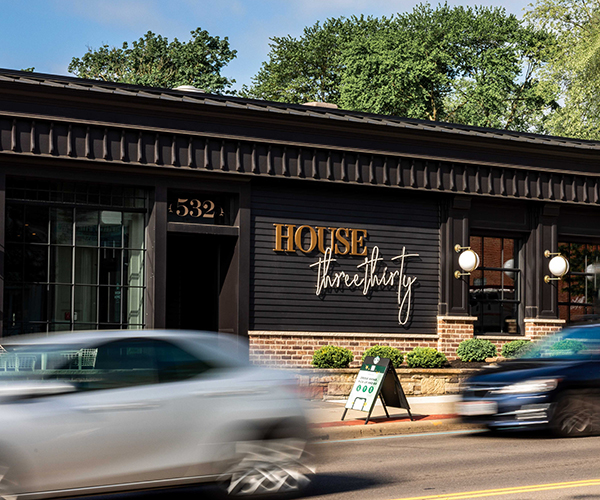Dean Heidelberg has been here all night — again.
Mostly, he's been working the saw, turning a 100-plus-year-old red oak from a Lakewood backyard into 1-inch-thick sheets of wood likely to end up as cabinets or trim.
He keeps a pillow here for nights like this. But the only sleeping option is with his head on his desk. He knows the smart thing would be to go home to his bed. But just across the street in his log yard on Cleveland's Train Avenue sits 2 million pounds of tree trunks.
"There's infinite work here," he says.
Heidelberg operates what is believed to be the first urban sawmill of its kind in the United States. He started Metro Hardwoods in October 1996 when he was only 23, long before the concept of upcycling became trendy. And although his work plants him squarely in the center of Cleveland's sustainability movement, he doesn't use the words "green" or "eco-friendly" or anything of the sort.
Normally, when he talks, his inquisitive nature leads him from one topic to the next. One minute it's dendrology (the study of trees), then politics, then industrial design.
So it's a bit strange to think that a middle-class kid from Lakewood with a NASA aeronautical engineer father and an art teacher mother would grow up to spend more than 100 hours a week on the painstakingly singular focus of cutting, stacking, drying and planing logs into lumber. But it is also the only thing that ever made any sense at all to Heidelberg.
For him, it's as simple as collecting leaves for a grade-school project: "No one else was doing it," he says, "and the logs were being wasted."
The pin oaks formed a bronze canopy over Clifton Boulevard when Larry and Kathy Heidelberg brought their newborn son home from the hospital in October 1972.
As a toddler, it became clear that Heidelberg was both adventurous and curious. He stuck a screwdriver in a socket when he was trying to "fix" the wiring as he saw his dad do. When he was not even 2 years old, he climbed a ladder leaning against his house. "He was most of the way to the second floor," Larry says.
In elementary school, Heidelberg came across a book about trees and labeled every species in his yard. "That was our first sign that trees were an interest," Kathy says.
That interest grew quickly. Heidelberg remembers rowing along the shore of Lake Erie looking for driftwood or boards that came loose from docks after a storm. His dad picked him up in his van and hauled the wood home for the tree fort Heidelberg built with his friends, adding on until the structure was three stories.
"I think a lot of his interest in his business started at Clifton Beach," Larry says. He and his son would go down there and collect logs for firewood. They noticed one day that some of the wood was dark. "It turned out to be black walnut," Larry says. "That intrigued us."
It would have been a perfect existence, except for one thing — school and homework. When a class interested Heidelberg, he did well in it, but most seemed irrelevant to him. "I almost found it insulting," Heidelberg says. "Am I supposed to waste all my time in school and out of school? I have all these things I want to do."
At 16, Heidelberg did show an interest in playing the guitar, but his mother quickly grew suspicious of his motives. "He was talking to the teacher about making guitars," she says. Heidelberg learned enough to construct about 20 guitars and even sold a handful at school.
As Heidelberg grew older, his projects grew bigger.
When he was 18, he saw a tree removal crew across from his house hauling away one of the first Clifton pin oaks to come down. He asked what they planned to do with the tree.
"They were going to dump it somewhere," Heidelberg remembers.
Instead, he talked them into unloading two tons of logs onto his parents' driveway. "I was lucky it didn't crack it," he says.
He began talking to city crews hauling away trees and found that the best-case scenario was that fallen trees ended up in a city dump and turned into firewood.
Heidelberg found the stash and was shocked by what he saw.
"You see this big pile of useful logs and a whole variety of species that could easily be made into lumber," he says. "And not one person was trying to do it."
Heidelberg knew how hard it was to find the maple, walnut and ash that he used to build his guitars — and how expensive it was when he did find it. I could use that lumber, he thought.
Had Heidelberg not had a father who worked as an engineer, the logs might have never made it past the fireplace. But he did. And Larry made what he calls a "very crude" sawmill: a gasoline powered band saw that was lightweight, portable and capable of cutting logs almost 2 feet in diameter.
And, with that, Heidelberg began milling lumber.
Heidelberg lives in central Lakewood underneath the shade of a large ash tree he knows he'll likely lose to the destructive emerald ash borer.
He jokes about suburbia: the huge 96-gallon garbage cans that seem to be overflowing every week and the two-story foyers of most new homes. But his teasing is good-natured, and he says he understands the desire to shelter your children.
The thing he does not understand is mulch.
"You'd think that it was the most popular thing in the world," he says.
He's not inherently opposed to the product if it's made from trees or branches not suitable to mill or from byproducts of the milling process, especially the bark, which holds up longer than mulch made from the wood of the tree.
That's not what's happening in much of Northeast Ohio, though. The street where Heidelberg grew up offers a good example. Many of the oaks, which typically live from 90 to 120 years, have died.
From 1997 to the mid 2000s, when a pin oak had to be removed on Clifton Boulevard, city crews often hauled it to Heidelberg's shop on the border of Cleveland's Stockyard and Detroit Shoreway neighborhoods. Now, they are all taken to the city log dump, because it's quicker and cheaper than taking them the few extra miles to Metro Hardwoods.
Heidelberg has several problems with that. The first is that when wood is turned into mulch or used for boiler fuel at a power plant, carbon dioxide, which is a greenhouse gas, is released into the atmosphere. If it's turned into furniture or flooring, that carbon is stored.
But his voice becomes more intense when explaining the second reason why logs should not be ground into mulch.
"Instead of coming here," he says, gesturing to his mill, "the logs are broken down into their lowest common denominator. They could be used for their highest purpose."
That's Heidelberg's purpose too.
When he cuts open a maple, each swipe of the saw is like turning the page of a book that chronicles its former glory. The grain could be curly or burled. The color could range from almost white to pink with the slightest hints of green. It's the narrative of the substantive, stately and inspiring told in subtlety and nuance.
A fine piece of furniture can capture all of that.
Paul White, the co-owner of P.D. White Furniture Maker in Tremont, buys Heidelberg's wood to build his custom-designed chairs, tables and desks. "My customers appreciate the character of urban wood," he says.
Meanwhile, people are going to furniture stores and paying hundreds of dollars, maybe more, for tables made of particleboard or even cardboard topped with an image of wood grain. "Some people actually think it's wood," Heidelberg says.
Heidelberg keeps a secret stash of his most treasured slabs — pieces that he only shows to those who share his appreciation of wood. One was a sheet of rare Russian olive with a tan complexion and swirly grain from Lakewood. White tried to buy it, but Heidelberg had only ever seen three logs of the variety and wasn't selling.
"Heidelberg loves trees," White says. "That's what keeps him going."
Heidelberg floundered a bit after high school. He took introductory classes briefly at Cleveland State University but couldn't see where it would ultimately get him.
"We talked about what he wanted to major in, and he had no idea," Kathy says. She knew her son well enough to know that if he had a specific goal, he'd do well.
Forestry seemed like a logical fit.
So Heidelberg headed south to Hocking College, one of two places in the state that offer forestry programs. It wasn't quite the fit his parents hoped.
Immediately, Heidelberg felt like it was a mistake to have moved to such an isolated location. He was used to getting places quickly and missed the density and convenience of Lakewood. "It was so inefficient driving so long to get anywhere," he says.
Worse, he knew that once he graduated, he'd likely end up working alone in a forest. "I didn't want to live in the middle of nowhere and scale trees," he says.
Then, in 1995, Heidelberg took a course called Forest Products. He observed his first extensive saw mill operation on a class trip and witnessed everything from the log yard to debarking to the actual milling and drying. "I could see every step," he says. "I could get a good idea as to what it actually takes."
Finally, everything added up — the tagging trees as a child, collecting driftwood, seeing the huge oaks taken down on Clifton, the black walnut logs on the beach, the mill in his backyard.
I can do this, he thought. I can do this.
Heidelberg has the kind of lean muscle and agility that comes from actual work, not working out at the gym. His girlfriend calls him "MacGyver" because of how quickly and how hard he works, and today is no different.
He climbs onto a contraption that looks like a cross between a forklift and a backhoe as quickly as a superhero saving the day. Right now, he needs a white oak that lies near the entrance to the yard, and he has it on his yard lift after about five minutes of moving other logs out of the way.
He moves quickly, yes, but with precision. When he needs a log that is farther back in the yard, he can easily spend an hour moving logs into piles to get the species of tree he's after.
Railroad tracks, a U-Haul rental lot and a warehouse border his yard. There is no room to expand.
Everything would be easier if he bought a few acres in the country, but Heidelberg chose his location deliberately. He's not interested in cutting down trees in a forest and turning them into planks. He started his business to save the trees that were coming down anyway, either from storms, old age or the bad luck of being in the way of a deck or home addition. And the best of those trees can all be found within a 20-mile radius of him, in the neighborhoods of Cleveland and its older suburbs.
"The trees are here, and the customers are here," he says. "The trees weren't being utilized."
What Heidelberg is describing is the very heart of the sustainability movement. "Being able to take that material and upcycle it is tremendously important to creating a sustainable economy," says Andrew Watterson, Cleveland's former chief of sustainability. "Street trees are undervalued, and Metro Hardwoods is helping tell that story."
As the sustainability movement grows, markings in the wood that were once considered flaws are now thought of as adding character. The iron in nails, for example, oxidizes with the acid in the wood to, in most species, create a bluish tint where the nail was. Also, trees form differently when they are subjected to the stresses of urban life. "Forest logs tend to grow more generically with less spectacular grain," Heidelberg says.
Back inside his facility, Heidelberg uses the yard lift to drop the oak onto the smaller of his two saws. He puts his ear plugs in and begins to work the saw, first trimming off the surface of the log, then sawing the tree into sheets of wood about 1 foot wide and 8 feet long. He lifts each one off the saw as it is done and stacks them in a pile before they go into the kiln.
He usually goes over a tree with a metal detector first because a nail from a garage sale sign or an old clothesline hook is the quickest way to ruin a saw, but this log is from higher up on a tree where metal is rarely found. After the planks dry, they'll be turned into custom floorboards for a Lakewood home where part of the original floor needed to be replaced.
The frustrating part of this job is that each swipe of the saw takes almost a full minute. "It's like being stuck in traffic," he says.
But Heidelberg's mind is always on two tracks — one that focuses on manning the saw or stacking the lumber and the other always thinking of ways to work more efficiently or improve the business. Any breaks Heidelberg takes are spent looking up answers on the Internet.
Heidelberg's current obsession is machine design. He'd like to have a planer big enough to smooth out the huge sheets of lumber that can be turned into tables, countertops or bar tops. Instead of buying one, which could cost upward of $30,000, Heidelberg and his dad are designing and building one together that meets his exact specifications and needs.
By January or February, he hopes to be selling these giant slabs. The big question is at what price. When Heidelberg started his mill, one of his goals was to keep his prices low. He has done that, but the result is that he works more than 100 hours a week for modest financial gains.
Between the investment in the equipment, the logistics of obtaining logs and the fact that the work is so physically demanding, anyone else would have given up, Larry says. "It's been tremendous aggravation, and it was years before he made any money at all," he says. "But he just wants to do this, and he won't give up. That's what it takes to make this work."
The tabletops that Metro Hardwoods will begin offering are sold in other parts of the country at prices that Heidelberg simply cannot fathom. A quick search reveals that a slab of maple, ash or oak can easily cost upward of $1,000 and a finished table could go for as much as $8,000.
"It's really tough," he says, "because it conflicts with my personality. I always wanted a place where you can afford the wood."
Compounding Heidelberg's dilemma is that some people expect to be paid for trees that come down on their property, even if there's not much of a market for them. Heidelberg gets most of his logs from tree services that are happy for an easy way to get rid of the timber.
So Heidelberg is still struggling with pricing the slabs of maple, oak, ash, elm, cherry and walnut he'll be selling. Yes, he wants financial security, but it's never been his primary goal. At the same time he talks about taking his business in a new direction with more specialized products, he also talks about working harder to mill more trees.
Heidelberg would like to increase his production capacity to five times what it is now. In other words, save a lot more trees from ending up in tiny pieces on front lawns.
"There is an incredible amount being wasted," he says. "I don't even like to think about it."
And that's what keeps Heidelberg up all night, working the mill and dreaming of ways to do more.
"Those grinders can process them far quicker than I ever could," he says.



